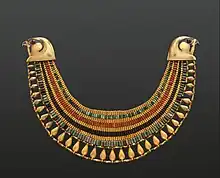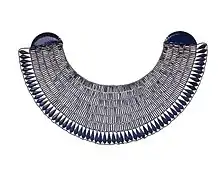Usekh collar
As early as the Old Kingdom (c. 2670–2195 B.C.), Egyptian artisans fashioned images of deities, kings, and mortals wearing broad collars made of molded tubular and teardrop beads.[1] The Usekh or Wesekh is a personal ornament, a type of broad collar or necklace, familiar to many because of its presence in images of the ancient Egyptian elite. Deities, women, and men were depicted wearing this jewelry. One example can be seen on the famous gold mask of Tutankhamun. The ancient word wsẖ can mean "breadth" or "width" in the Ancient Egyptian language and so this adornment is often referred to as the broad collar.




The usekh broad collar was wrapped around and supported by the neck and shoulders. It is typically adorned with closely placed rows of colored stone beads, or it is made entirely of metal. The collars were connected with clasps of gold.[2]
Over time, the broad collar went through many different variations of form. These could be attributed to shifting mythological perspectives, or perhaps due to geographical movement across Egypt.
A scene in the Fourth Dynasty tomb of Wepemnofret at Giza connects the usekh collar with dwarves and the deity Ptah. Bernd Scheel has argued that Ptah, who is sometimes depicted wearing the broad collar, protects the deceased through the collar and that dwarves had access to that protective magic, because of their work making these types of collars.[3] In the Fifth Dynasty tomb chapel of Akhethotep (originally located at the Saqqara burial ground, but now in the Louvre), one scene distinguishes between two types of collars: the broad collar and the šnw or "encircling" collar.[4]
See also
References
- Museum, Brooklyn. "Broad collar". BrooklynMuseum.org. Brooklyn Museum. Retrieved May 4, 2021.
- "Usekh Collar". Archived from the original on 2009-07-25. Retrieved 2009-03-28.
- Scheel, Bernd (1999). "Ptah und die Zwerge". In Altenmüller, Hartwig; Germer, Renate (eds.). Miscellanea Aegyptologica: Wolfgang Helck zum 75. Geburtstag. Hamburg: Archäologisches Institut der Universität Hamburg. pp. 159–164.
- Brovarski, Edward (1997). "Old Kingdom beaded collars". In Phillips, Jacke (ed.). Ancient Egypt, the Aegean, and the Near East: Studies in Honour of Martha Rhoads Bell. [San Antonio]: Van Siclen Books. pp. 137–162.